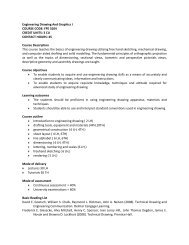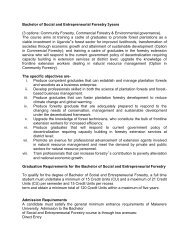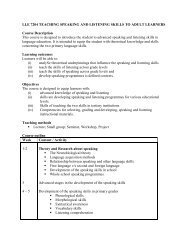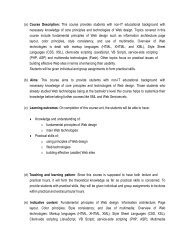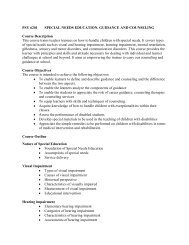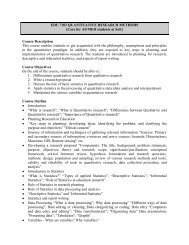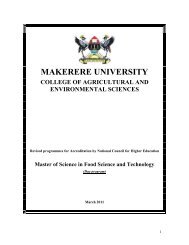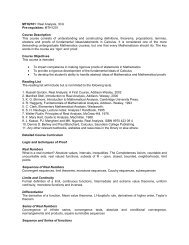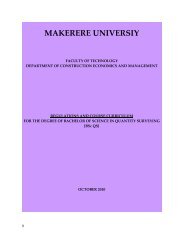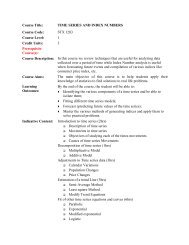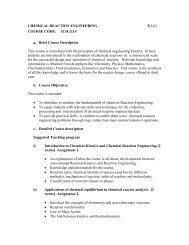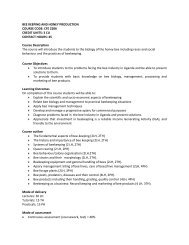MAKERERE UNIVERSITY - Office of the Academic Registrar ...
MAKERERE UNIVERSITY - Office of the Academic Registrar ...
MAKERERE UNIVERSITY - Office of the Academic Registrar ...
Create successful ePaper yourself
Turn your PDF publications into a flip-book with our unique Google optimized e-Paper software.
Course OutlineIntroduction“What is research”; “What is Quantitative research”; “Differences between Qualitative andQuantitative research”; “Importance <strong>of</strong> Quantitative research”.Planning Research in Education“Key steps in planning: developing ideas, identifying <strong>the</strong> problem, and clarifying <strong>the</strong>purpose and objectives” “Ethical consent”Sources <strong>of</strong> information and techniques <strong>of</strong> ga<strong>the</strong>ring relevant information “Sources: Primaryand secondary sources <strong>of</strong> information; e-sources and non-e sources; Journals; Dissertations;Museums; GIS; Remote sensing” etc.Developing a research proposal “Components: The title, background; problem statement,purpose, objectives, <strong>the</strong>ory and research, scope, significance/justification; conceptualframework, critical literature review, hypo<strong>the</strong>sis formulation and research questions,methods: design, population and sampling; review <strong>of</strong> various research methods and tools;validity and reliability <strong>of</strong> tools in quantitative research; data collection procedure; andanalysis”Introduction to Statistics“What is Statistics?” “Types <strong>of</strong> applied Statistics”; “Descriptive Statistics”; “InferentialStatistics”; “Role <strong>of</strong> Statistics in education research”Role <strong>of</strong> Statistics in research planningRole <strong>of</strong> Statistics in data processing and analysis“Descriptive Statistics” and “Inferential Statistics”Statistics and report writingData Processing “What is data processing”; Why data processing” “Different ways <strong>of</strong> dataprocessing”; Data editing or cleaning; Data categorizing or coding; Data entry “Computersand data entry and editing”; “Data transformation”; “Organizing data” Data presentation;“Presenting data”; “Tabulation”; “Graphs”Variables - What are variables? Why variables?Types <strong>of</strong> variables - “Types <strong>of</strong> Research variables” ; Coombs: “Categorical variables”;“Numerical variables”; Relationship between categorical and numerical variables” Accordingto <strong>the</strong>ir role in research: “Dependent variable”; “Independent variable”; “Extraneousvariable”; “Moderator variable” Types <strong>of</strong> analysis according to number <strong>of</strong> variablesDescriptive Data AnalysisIntroduction” What is descriptive data analysis?”; Analysis <strong>of</strong> frequencies or frequencycounts; “Relative frequency”; “Relative percentage frequency distribution”; 5.3Analysis <strong>of</strong> central tendency or location; “Measures <strong>of</strong> central tendency”; Analysis <strong>of</strong>dispersion; “Measures <strong>of</strong> dispersion”; 5 Analysis <strong>of</strong> skew; “Plotting distributions”; “Shapes<strong>of</strong> distributions”; “Relationship among mean, mode and median”Introduction to Inferential Data Analysis - “What is inferential data analysis?” Inferentialversus descriptive data analysis; “Descriptive Statistics”; “Inferential Statistics” ;Terminology in inferential data analysis; “Population and sample”; “Sampling”;“Inferences”; Estimation <strong>of</strong> parameters; “Point and interval estimates” Test <strong>of</strong> hypo<strong>the</strong>ses;“Concepts in hypo<strong>the</strong>sis testing: What is a hypo<strong>the</strong>sis?” “Why hypo<strong>the</strong>sis”13



